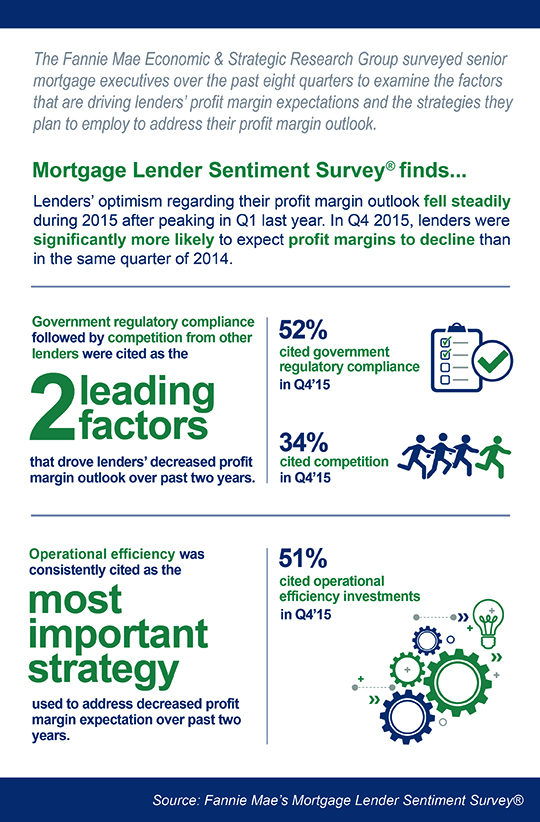Fannie Mae Survey Shows Profit Margin Compression a Top Issue for Mortgage Executives

Over the past two years, the mortgage industry has faced both challenges and opportunities. The U.S. economy has improved significantly since the Great Recession, with strengthening labor markets and historically low interest rates helping the housing market to recover. However, household formation has been depressed, raising lenders' concerns about the growth in mortgage demand. Additionally, a number of new rules and recent regulatory changes, including TRID (TILA-RESPA Integrated Disclosure), have increased lenders' compliance costs.1
Lenders tell us these trends are impacting their business operations and profitability. The Economic & Strategic Research Group at Fannie Mae surveyed senior mortgage executives through its quarterly Mortgage Lender Sentiment Survey® to examine the factors that are driving lenders' profit margin expectations and the strategies they plan to employ to address their profit margin outlook.
The survey results show that, despite continued modest housing market expansion since the Great Recession, lenders are somewhat pessimistic regarding their profit margin outlook. The share of lenders expecting their profit margin to increase over the next three months fell steadily during 2015. When compared with the prior year (2014), more lenders reported expectations of declining profit margins in 2015 and into early 2016.
Survey results suggest that lenders' pessimistic profit margin outlook is driven by two leading factors:
- "Government regulatory compliance": The share of lenders citing this as one of the two most important factors reached a survey high of 61 percent in Q3 2015, indicating the impact of TRID, which has been a challenge for many lenders. The workflow changes and technology updates necessary to help ensure compliance have been significant, according to lenders.
- "Competition from other lenders": The concern with increased market competition could be attributed to lenders' continued concerns with mortgage demand growth. With the refinance boom ending, lenders are competing for a smaller origination market.2 Survey results also show that lenders today are less likely than they were in 2014 to use new mortgage products or to expand marketing programs as strategies to increase their profit margin, indicating fewer opportunities for lenders to exploit. Part of this can be explained by the maturing of the Housing Affordable Refinance Program (HARP), which currently is set to expire at the end of 2016. Many lenders have successfully leveraged this program, but fewer HARP opportunities remain.
When asked what strategies they plan to deploy to address their shrinking profit margin outlook, lenders consistently cite "operational efficiency" as the most important, holding steady throughout 2015. Although lenders continue to face challenges from rising compliance costs and competitive pressure, this tough business environment creates an opportunity for lenders to harness these challenges to create competitive advantage. Companies are finding innovative ways to leverage technology, streamline processes, optimize staff, and maximize vendor performance to not only maximize operational efficiency, but to also provide a better customer experience.
To learn more, read our Fannie Mae Mortgage Lender Sentiment Survey "Profit Margin" Special Topic Analysis.

Steve Solomon, Director
Customer Strategy and Insights
Single-Family Mortgage Business
March 3, 2016
The author thanks Carol Bell, Tom Seidenstein, and Doug Duncan for valuable comments in the creation of this commentary and the design of the topic analysis questions. Of course, all errors and omissions remain the responsibility of the author.
Opinions, analyses, estimates, forecasts and other views reflected in this commentary should not be construed as indicating Fannie Mae's business prospects or expected results, are based on a number of assumptions, and are subject to change without notice. How this information affects Fannie Mae will depend on many factors. Changes in the assumptions or the information underlying these views could produce materially different results.
1 Examples include the Mortgage Banking booklet (https://occ.gov/publications/publications-by-type/comptrollers-handbook/ch-mortgage-banking.pdf ), the Ability To Repay/Qualified Mortgage standards (https://www.consumerfinance.gov/regulations/ability-to-repay-and-qualified-mortgage-standards-under-the-truth-in-lending-act-regulation-z/#rule), the Basel III capital requirements (https://www.federalreserve.gov/bankinforeg/basel/USImplementation.htm or https://www.fdic.gov/news/board/2014/2014-04-08_notice_dis_c_fr.pdf ) and the Truth in Lending Act (TILA)/Real Estate Settlement Procedures Act (RESPA) Integrated Disclosure (TRID) Rule (https://www.consumerfinance.gov/regulatory-implementation/tila-respa/).
2 Because of the rising rate environment, Fannie Mae’s Economic and Strategic Research Group expects the mortgage market to tilt further toward purchase loans going forward. We expect the refinance share of originations to trend down from 46 percent in 2015 to 32 percent in 2016. For more details, please see https://www.fanniemae.com/resources/file/research/emma/pdf/Economic_Summary_011416.pdf
